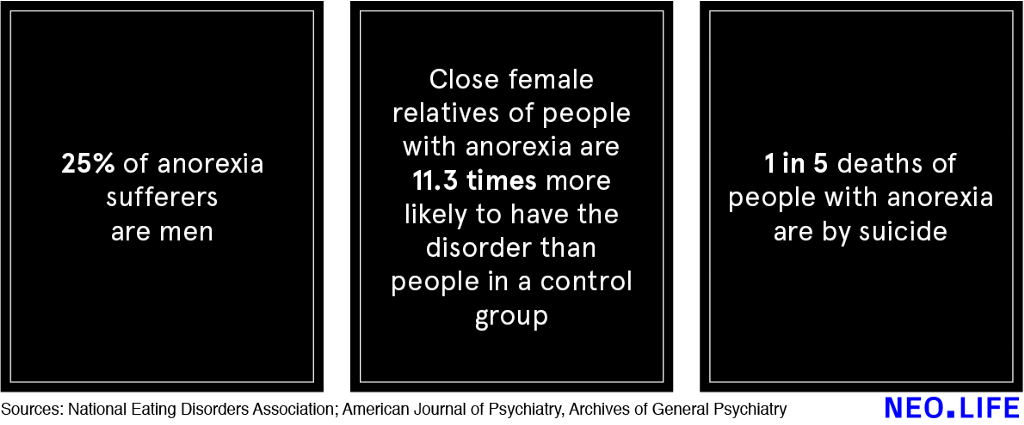Skinny Genes
Anorexia may originate in your gut and your DNA, not in fashion magazines.
I first met Kristina Saffran, a blonde and elegant Harvard graduate in a full-length ball gown at a swanky benefit in San Francisco. Moments later, she addressed a crowd of Silicon Valley tycoons about the gaps in funding for eating disorder treatment. By the end of the evening, after Saffran invited a group of young men and women to share their struggles with the disease, there wasn’t a dry eye in the house.
Saffran and I reconnected a month later at an old Italian coffee shop in the North Beach neighborhood of San Francisco. She ordered a green tea and began telling me about her personal struggle with anorexia nervosa. “I weighed 75 pounds at 14,” she told me — a dangerously low weight for her age. After making a full recovery, her mission now is to change misconceptions about the disease. “It’s seen as a white girl vanity issue,” she continued. “It’s the most under-funded, stigmatized disease.”
These days, the scientific community is increasingly on her side. With new tools like DNA sequencing at their disposal, researchers are finding that the disease is not psychological — or the fault of the fashion industry for promoting unhealthy body image. In fact, many now believe that such stereotypes have held back important, evidence-based research, as well as potential new treatments. That’s a big problem, given that anorexia affects millions of people and is ranked as the most fatal mental disorder, with a mortality rate of 10 percent.
One of Saffran’s strongest academic allies is Cynthia Bulik, a former dancer turned academic who thinks that the old stereotypes that blame media and a woman’s psychology are inhibiting understanding and treatment. “We have been trying to present the new science without the baggage of the inaccurate history,” says Bulik, a clinical psychiatrist and the founding director of the University of North Carolina Center of Excellence for Eating Disorders.
Researchers are finding that the disease is not psychological — or the fault of the fashion industry for promoting unhealthy body image.
Bulik has long been fascinated with the question of why so many people with eating disorders report feeling calm and in control after restricting calories. She has seen it firsthand with her own patients, as well as in her previous career as a professional figure skater. “Most of us don’t like being in a negative energy balance, where we’re eating less than we’re expending,” she explains. “But many of those who are prone to anorexia are anxious at baseline, and then the negative energy seems to balance them.”
In Saffran’s case, restricting calories alleviated her anxiety, prompting her to research how her brain functions differently from her peers’. She is particularly optimistic about the potential of genetics to unlock pervasive mysteries about the disease. “I want to understand why some people’s bodies are more predisposed to punishment than reward.”
Some people can tolerate restricting calories far better than others, which scientists are still working to understand. Bulik is now working with an international cohort of researchers to better understand the genetic components of anorexia. It’s now widely understood that genetics, environmental factors and personality traits (one common one, according to Bulik, is “perfectionism”) combine to increase a person’s liability for an eating disorder.
Genes seem to play a larger role that many scientists had anticipated. A recent crop of family and twin studies suggest that eating disorders aggregate in families, with heritability estimates of 48 percent to 74 percent. To dive deeper, researchers from the United States, Sweden, Australia and Denmark kicked off the largest-ever genetic investigation in 2014 with funding from the Klarman Family Foundation. The scientists collected clinical information and blood samples from 13,000 people who had anorexia nervosa at some point in their lives, and compared them to a control group.
The process involved extracting and analyzing each person’s DNA to identify the specific genes that influence anorexia. Researchers looked for genetic variations that were more frequent in people with anorexia compared to those who were never diagnosed with the disease. “We are not expecting one gene,” says Bulik. “Instead, hundreds of genes of relatively small effect seem to combine in different ways among those with anorexia.” The final research paper is still under peer review, but Bulik expects the results to be published in 2017 or 2018.
One early finding from the research particularly struck Bulik: that people with anorexia have a naturally low body mass index (BMI) and even when doctors help them gain back a normal weight in the hospital, they still very quickly bounce back to their low BMI. “For some people, the low BMI seems to be what the body is gravitating to,” she says. “We don’t really understand the biology of this yet.”

Bulik is hoping that the scientific community will eventually come up with a risk score for developing an eating disorder, which takes into account both genetic and environmental factors. Another outcome could be new therapies that target the biological pathways that underlie the illness. Such targeted treatments don’t currently exist, but eventually they could prove to be helpful in preventing the onset of the disease and not just treating it.
Perhaps, she says, researchers will find a way to convince the body that a negative energy balance is not a desirable outcome. Finally, she suggests that this kind of research might be useful in more accurately diagnosing anorexia, as well as in preventing it among those who are at risk.
Genetics isn’t the only promising area of research. University of North Carolina microbiologist Ian Carroll heard about Bulik’s work and saw some unexpected parallels with his own. Carroll studies the complex community of bacteria, viruses and fungi that live harmoniously in our intestines. In some diseases, this microbial balance gets thrown off.
Carroll is particularly fascinated by so-called “gnotobiotic” animals, which are raised in sterile conditions that allow scientists to control their microbial environment. With far less diversity of microbes, these animals will experience symptoms like an underactive immune system and an ability to eat more without putting on weight.
After a meeting with Bulik, Carroll and his graduate students wondered what they’d discover by examining the gut microbiomes of people with anorexia before and after they’ve been re-fed in a clinical setting.
After analyzing fecal samples, his team found that people with anorexia appear to have a lower diversity of microbes both before and after re-feeding. That diversity had started to increase after the patients were taking in far more calories, but not significantly. They also found a correlation between anxiety and depression and low diversity of microbes in the gut.
Anorexia is ranked as the most fatal mental disorder, with a mortality rate of 10 percent.
One potential explanation for this is that in an environment where the body is being deprived of nutrients, some microbes will thrive and others will die off. Some of the microbes that survive could have evolved in a way that leads them to produce chemicals that function as neurotransmitters and give the individual a sense of wellbeing when they restrict calories, suggests Carroll. This is still unproven, but Carroll is hoping to secure more research grants for clinical studies in the coming years.
His goals for the research are to help people with anorexia gain weight in a safe and effective manner and to help doctors predict those who will recover more quickly. He also wants to help improve patients’ overall behavioral health. To these ends, he’s working with John F. Cryan at Ireland’s University College Cork Microbiome Institute to conduct experiments in mice with a similar microbiome. “This is cutting-edge stuff,” he says. “But bear in mind that it is the kind of research that gets a good bit of criticism, as there are microbes that love to survive in humans that don’t live in mice.”
Bulik agrees with this sentiment, but is hoping that the results will help win over other microbiologists in the field. “The microbiome research is such a new way of looking at this illness,” she adds.
Many researchers see major potential in so-called fecal transplants to address imbalances in the microbiome. The somewhat icky procedure is exactly what you might expect: it involves putting poop from one patient into another’s colon. Thus far, it has proven to be an effective treatment for an illness caused by a bacterium called Clostridium difficile, or C. diff. Carroll believes the next candidate for fecal transplants could be a patient with anorexia, to see whether re-establishing a diversity of microbes makes a difference. Carroll is collaborating with a company that he declined to name on a potential clinical trial.
Saffran sees huge potential in this collaborative research, and is even considering a career in academia. She believes that the findings from Bulik and Carroll’s research, as well as a handful of others, will help advocates build a case for much-needed funding for basic research and treatment. “The research has meant that we’re seeing far less stigma,” she says. “It’s a tiny field, but the disease is finally rising to national prominence.”




















